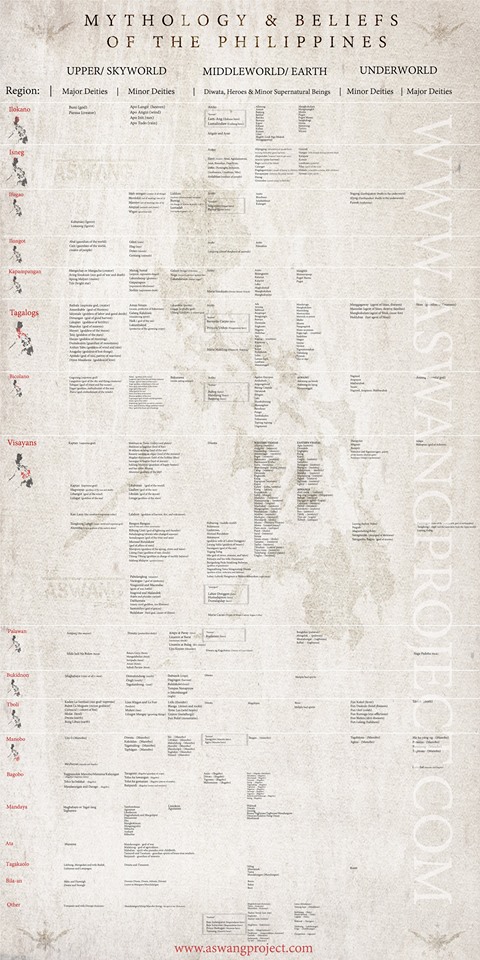I’m a very visual person. My office wall is plastered with thumb tacks, maps and strings from when I charted out the history and evolution of the Tikbalang and Kapre for the Creatures of Philippine Mythology web series I am working on. As I began researching future episodes (Bakunawa, Diwata, Tiyanak, and Manananggal), I realized that I was stuck in a labour intensive repetition of the research I had done previously. I found myself scouring over the belief systems of every region of the Philippines, and mentally charting it out – again! I would then cross reference with other research, historical documents and mythical stories from the Philippines and the surrounding countries. This has been part of my process since I began work on The Aswang Phenomenon back in 2006. It gets easier every time, but it still consumes far too much effort. This brings me to my issue with how Philippine Mythology is problematically charted. There is an obstinate effort to keep Philippine Mythology separated – the Deities and the Creatures. This is done to such a point that one is almost never mentioned within context of the other, yet they are clearly part of the same belief system.
The academic view on mythology has evolved and changed from how it was viewed in the past. Mythologizing is no longer considered just an ancient or primitive practice. A culture’s collective mythology helps convey belonging, shared and religious experience, behavioral models, and moral and practical lessons. The recent approach to mythology sees it more as expressions for understanding general psychological, cultural or societal truths. Shouldn’t the approach to Philippine Mythology follow suit? As was pointed out to me earlier today, “many indigenous Katutubo still believe in these beings.”
WHO’S TO BLAME?
This is partly the fault of the Spanish, and partly the fault of the Philippine academe. The Spanish successfully eliminated the belief in deities, idol worship and the need to center communities around the babaylan (spiritual leader, healer, seer). What they were not able to destroy was the belief in folkloric beings. This is partly because the Spanish wanted all “good” to be credited to God, coupled with the fact that there were no idols for the malevolent spirits. The mythical beings slipped under the radar as “superstition”, and there they have stayed. Before (and during) Spanish occupation, many of these spirits were given personalities and names. Most of today’s “creatures” in Philippine Mythology are right in line with what we know of folkloric beings and spirits in the pre-Spanish belief system – they can transform into part or the whole of an animal, disappear, may show itself in human form, and cause illness, death, miscarriages or a series of other maladies. This also aligns with the animist folk beliefs in countries surrounding the Philippines – Malaysia, Indonesia, and Southern Thailand (The Austronesian Peoples) – all without the help of the Spanish.
During the 20th century, when historians began exploring documents proving how the Spanish had destroyed the belief in deities, and even incorrectly classified some of them as “witches” and “devils”, there was a snap conclusion that assumed the creatures of Philippine Mythology were a result of that same process. This has been the steadfast position ever since – but I believe it is incorrect. I’ve charted the Major & Minor Deities, Minor Mythical Beings (creatures) and the Heroes of the Philippines into the regions of their origin. This is by no means inclusive of every single ethnic group in the Philippines, but it includes the major ones. My plan is to continue this as a work in progress (subscribe below to stay up to date).
THE SOLUTION
I believe that it is time to stop separating Philippine Mythology and to begin looking at the whole picture. The creatures are part of the entire pantheon and they have been kept alive through the oral traditions of storytellers, and yes, through superstition.
Philippine Mythology is fascinating, beautiful, terrifying, and confusing. Eliminating the separation between benevolent deities and malevolent spirits lessens this confusion and gives a greater understanding of its magnificence. It should be taught in schools throughout the country and treated as a point of national pride.
Here is the Current Chart of Philippine Mythology. Please note that this is a work in progress and will be released once I feel it is complete.

Jordan Clark is a Canadian born descendant of Scottish immigrants living on the homelands of the Lekwungen speaking peoples. His interest in Philippine myth and folklore began in 2004. Finding it difficult to track down resources on the topic, he founded The Aswang Project in 2006. Shortly after, he embarked on a 5 year journey, along with producing partner Cheryl Anne del Rosario, to make the 2011 feature length documentary THE ASWANG PHENOMENON – an exploration of the aswang myth and its effects on Philippine society. In 2015 he directed “The Creatures of Philippine Mythology” web-series, which features 3 folkloric beings from the Philippines – the TIKBALANG, KAPRE and BAKUNAWA. Episodes are available to watch on YouTube. Jordan recently oversaw the editing for the English language release of Ferdinand Blumentritt’s DICCIONARIO MITOLÓGICO DE FILIPINAS (Dictionary of Philippine Mythology) and is working on two more releases with fellow creators scheduled for release later this year. When his nose isn’t in a book, he spends time with his amazing Filipina wife of 20 years and their smart and wonderful teenaged daughter.


